Consolidated Balance Sheet Excel template with examples

Use the Excel Consolidated Balance Sheet model spreadsheet to enter your company data, and let the formulas do all the work and calculations for you. Obtain in a simplified way the total values of assets and liabilities (detailed also in current, non-current, permanent, etc.), in addition to your net worth.
What is a Balance Sheet
A Balance Sheet is an accounting document and a financial statement of your company’s activity, which determines whether it is profitable or not. The purpose of a balance sheet is to give investors an idea as to what the company owns and owes.
This can also be a management tool: the balance of rights to receive and obligations can be used to assess the economic and financial situation of the business, identify trends in inflows and outflows (accounts receivable and accounts payable), and support the taking of strategic decisions.
Breaking it down
The balance sheets gets its name from the fact that the two sides of the equation above – assets on the one side and liabilities plus shareholders’ equity on the other – must balance out. This is intuitive: a company has to pay for all the things it owns (assets) by either borrowing money (taking on liabilities) or taking it from investors (issuing shareholders’ equity).

Assets, liabilities and shareholders’ equity are each comprised of several smaller accounts that break down the specifics of a company’s finances. These accounts vary widely by industry, and the same terms can have different implications depending on the nature of the business. Broadly, however, there are a few common components investors are likely to come across.
Assets:
Within the assets segment, accounts are listed from top to bottom in order of their liquidity, that is, the ease with which they can be converted into cash. They are divided into current assets, those which can be converted to cash in one year or less; and non-current or long-term assets, which cannot.
Liabilities
Liabilities are the money that a company owes to outside parties, from bills it has to pay to suppliers to interest on bonds it has issued to creditors to rent, utilities and salaries. Current liabilities are those that are due within one year and are listed in order of their due date. Long-term liabilities are due at any point after one year.
Shareholders’ equity
Shareholders’ equity is the money attributable to a business’ owners, meaning its shareholders. It is also known as “net assets,” since it is equivalent to the total assets of a company minus its liabilities, that is, the debt it owes to non-shareholders.
How To Interpret a Balance Sheet
The balance sheet is a snapshot, representing the state of a company’s finances at a moment in time. By itself, it cannot give a sense of the trends that are playing out over a longer period. For this reason, the balance sheet should be compared with those of previous periods. It should also be compared with those of other businesses in the same industry, since different industries have unique approaches to financing.
A number of ratios can be derived from the balance sheet, helping investors get a sense of how healthy a company is. These include the debt-to-equity ratio and the acid-test ratio, along with many others. The income statement and statement of cash flows also provide valuable context for assessing a company’s finances, as do any notes or addenda in an earnings report that might refer back to the balance sheet.
Click here to download our Free Balance Sheet Format Template!
Combine this free template with other tools:
Income Statement
Cash flow statement
Horizontal and Vertical Analysis
Petty Cash Book
See our Full Version Templates:










